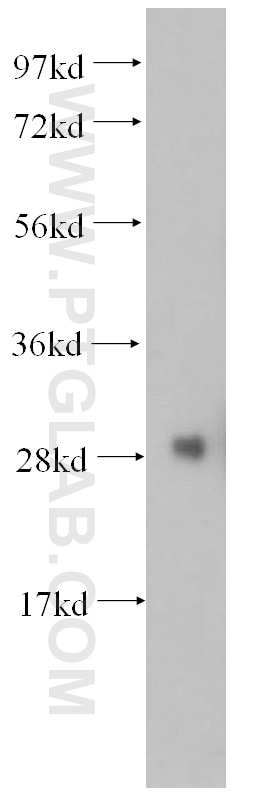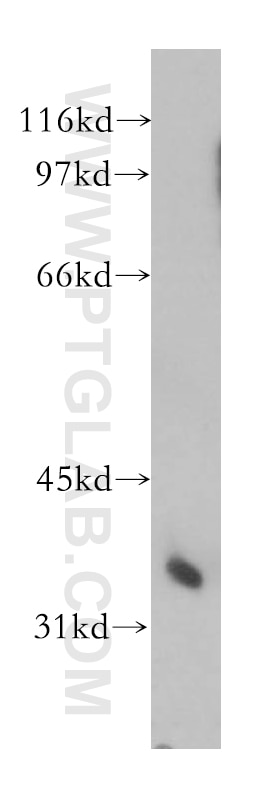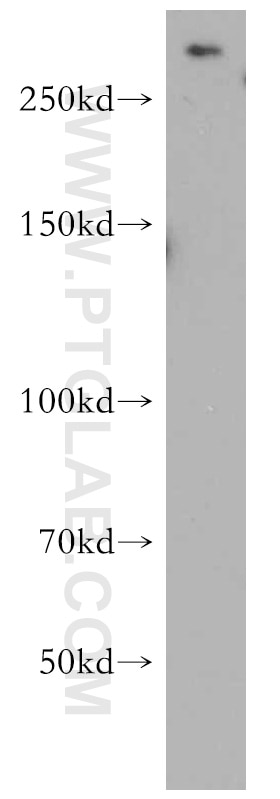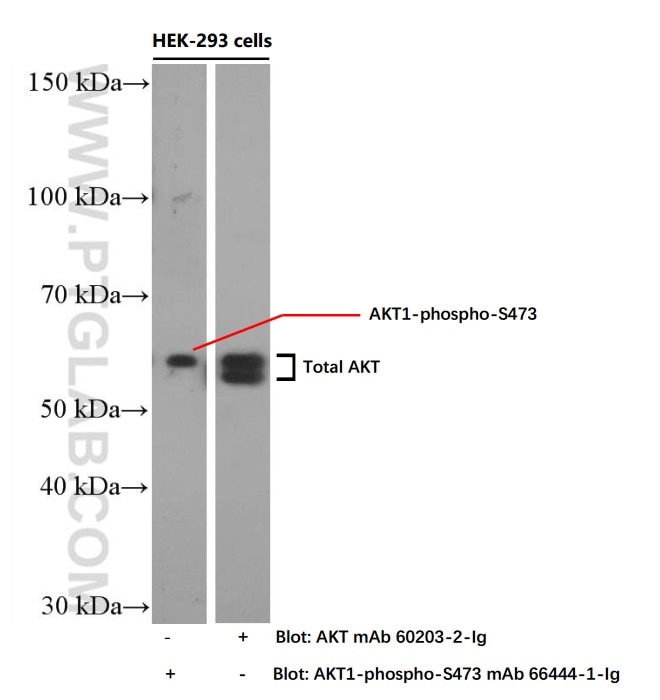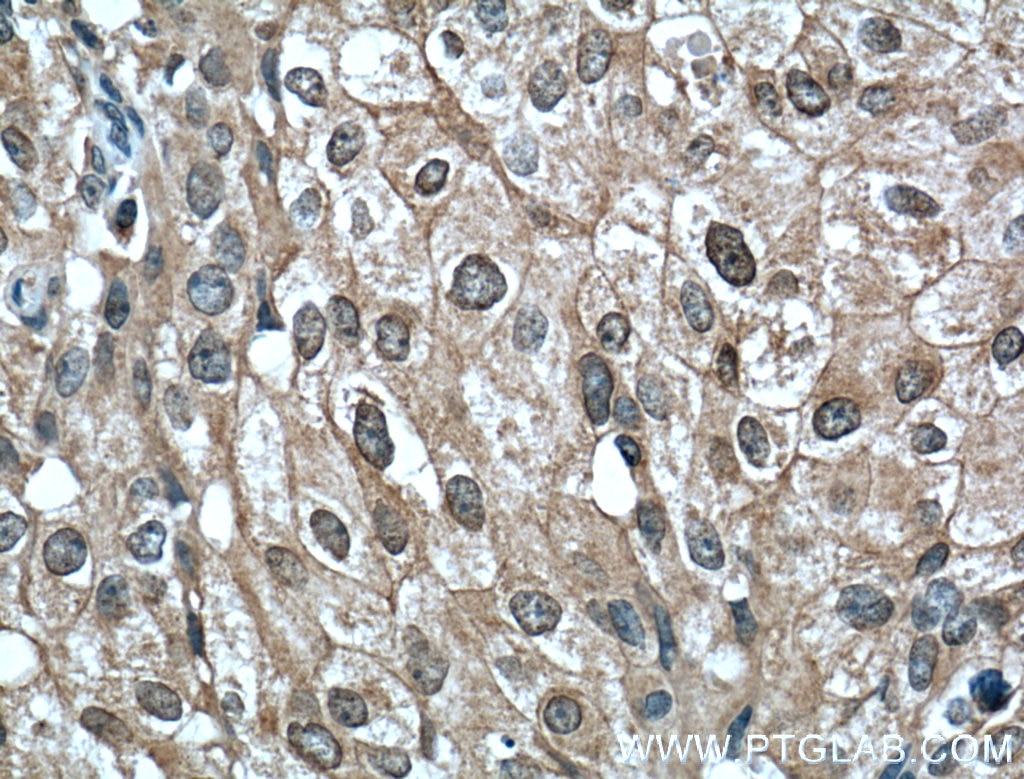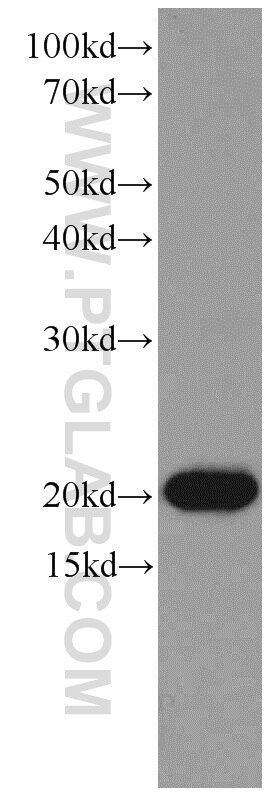- Phare
- Validé par KD/KO
Anticorps Polyclonal de lapin anti-p70(S6K)
p70(S6K) Polyclonal Antibody for WB, IP, IF, IHC, ELISA
Hôte / Isotype
Lapin / IgG
Réactivité testée
Humain, rat, souris et plus (3)
Applications
WB, IHC, IF/ICC, IP, ELISA
Conjugaison
Non conjugué
157
N° de cat : 14485-1-AP
Synonymes
Galerie de données de validation
Applications testées
| Résultats positifs en WB | cellules HEK-293, cellules C6, cellules HeLa, cellules Jurkat, cellules MCF-7 traitées à l'IGF-1, cellules NIH/3T3, cellules PC-12, tissu cérébral de rat, tissu cérébral de souris |
| Résultats positifs en IP | cellules HeLa |
| Résultats positifs en IHC | tissu de cancer du foie humain, il est suggéré de démasquer l'antigène avec un tampon de TE buffer pH 9.0; (*) À défaut, 'le démasquage de l'antigène peut être 'effectué avec un tampon citrate pH 6,0. |
| Résultats positifs en IF/ICC | cellules HepG2, |
Dilution recommandée
| Application | Dilution |
|---|---|
| Western Blot (WB) | WB : 1:2000-1:8000 |
| Immunoprécipitation (IP) | IP : 0.5-4.0 ug for 1.0-3.0 mg of total protein lysate |
| Immunohistochimie (IHC) | IHC : 1:50-1:500 |
| Immunofluorescence (IF)/ICC | IF/ICC : 1:10-1:100 |
| It is recommended that this reagent should be titrated in each testing system to obtain optimal results. | |
| Sample-dependent, check data in validation data gallery | |
Applications publiées
| KD/KO | See 2 publications below |
| WB | See 153 publications below |
| IHC | See 3 publications below |
| IF | See 2 publications below |
Informations sur le produit
14485-1-AP cible p70(S6K) dans les applications de WB, IHC, IF/ICC, IP, ELISA et montre une réactivité avec des échantillons Humain, rat, souris
| Réactivité | Humain, rat, souris |
| Réactivité citée | rat, Humain, Lapin, porc, souris, Megalobrama Amblycephala |
| Hôte / Isotype | Lapin / IgG |
| Clonalité | Polyclonal |
| Type | Anticorps |
| Immunogène | p70(S6K) Protéine recombinante Ag5883 |
| Nom complet | ribosomal protein S6 kinase, 70kDa, polypeptide 1 |
| Masse moléculaire calculée | 59 kDa |
| Poids moléculaire observé | 65-75 kDa, 80-85 kDa |
| Numéro d’acquisition GenBank | BC053365 |
| Symbole du gène | p70 S6K |
| Identification du gène (NCBI) | 6198 |
| Conjugaison | Non conjugué |
| Forme | Liquide |
| Méthode de purification | Purification par affinité contre l'antigène |
| Tampon de stockage | PBS avec azoture de sodium à 0,02 % et glycérol à 50 % pH 7,3 |
| Conditions de stockage | Stocker à -20°C. Stable pendant un an après l'expédition. L'aliquotage n'est pas nécessaire pour le stockage à -20oC Les 20ul contiennent 0,1% de BSA. |
Informations générales
RPS6KB1(Ribosomal protein S6 kinase beta-1) is also named as STK14A, p70 S6KA, and belongs to the S6 kinase subfamily. RPS6KB1 is a major substrate of mTOR and acts as a crucial effector of mTOR signaling pathway. It plays a key role in cell growth and proliferation by regulating INS sensitivity, metabolism, protein synthesis, and cell cycle. RPS6KB1 may play an important role in the progression of HCC and could serve as a potential molecular target for HCC therapy (PMID:22684641). The Rps6kb1 gene encodes the 70 kDa ribosomal protein S6 kinase (p70S6K). The PI3K/mTOR signalling pathway is one of the major mechanisms for controlling cell survival, proliferation, and metabolism and is the central regulator of translation of some components of the protein synthesis system. Due to alternative translation, two isoform S6K1 proteins are known to exist in mammalian cells: p85 S6K1 and p70 S6K1, which is identical to p85 S6K but lacks its first 23 amino acids. In addition, mammalian cells express a second S6K1 isoform spanning 316 amino acids (p31 S6K1).
Protocole
| Product Specific Protocols | |
|---|---|
| WB protocol for p70(S6K) antibody 14485-1-AP | Download protocol |
| IHC protocol for p70(S6K) antibody 14485-1-AP | Download protocol |
| IF protocol for p70(S6K) antibody 14485-1-AP | Download protocol |
| IP protocol for p70(S6K) antibody 14485-1-AP | Download protocol |
| FC protocol for p70(S6K) antibody 14485-1-AP | Download protocol |
| Standard Protocols | |
|---|---|
| Click here to view our Standard Protocols |
Publications
| Species | Application | Title |
|---|---|---|
Cell Stem Cell Amino acid catabolism regulates hematopoietic stem cell proteostasis via a GCN2-eIF2α axis. | ||
Small Methods PROTAC Degraders of Androgen Receptor-Integrated Dissolving Microneedles for Androgenetic Alopecia and Recrudescence Treatment via Single Topical Administration | ||
Cell Death Differ Lysine methylation of PPP1CA by the methyltransferase SUV39H2 disrupts TFEB-dependent autophagy and promotes intervertebral disc degeneration | ||
Redox Biol Aberrant hyper-expression of the RNA binding protein GIGYF2 in endothelial cells modulates vascular aging and function | ||
Autophagy SMCR8 negatively regulates AKT and MTORC1 signaling to modulate lysosome biogenesis and tissue homeostasis. |
-Antibody-14485-1-AP-WB-268098.jpg)
-Antibody-14485-1-AP-WB-428140.jpg)
-Antibody-14485-1-AP-WB-484367.jpg)
-Antibody-14485-1-AP-WB-180462.jpg)
-Antibody-14485-1-AP-IP-35809.jpg)
-Antibody-14485-1-AP-IHC-252307.jpg)
-Antibody-14485-1-AP-IF-17645.jpg)
-Antibody-14485-1-AP-IF-408919.jpg)
